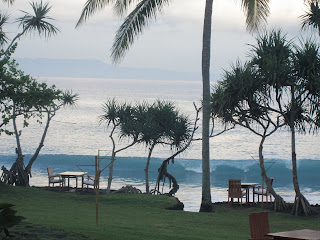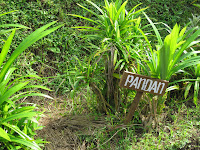ta-daa. assalamualaikum & hye hye. ingt tak hari tu sy ade post ttg kwn lame sy dah kawin kan kan? post ni. sila klik ye, dan ni lahhh 1st picture kawin die yg sy dpt tgk! ngee. eeda, muke kalian mmg sepadan. err, maksud sy, kalian sepadan. comelll gile comelll gile.
owh ye, sy nak kongsikan post di blog die. hari tu ade jgk msg through FB. excited! hee. btw, post ni best, sbb bg sy sgtlah bermakna. nak bagi URL kang memandai lak kang. so sy copy paste dan sila bace & hayati, dan belajar, jdkan tauladan mane yg baik! ;)

| Imran & Iman -21.Rejab(7). 1431; 3.7.10- |
Tenang rasanya hatiku mencintaimu... kerana cinta ini telah dihalalkan buat kita...
Semoga cinta ini mendekatkan kita kepada redhaNya, mardhatillah.
Teruslah dikau menjadi semangatku wahai mujahid habibi...Love you fillah.Insha Allah.
Alhamdulillah.. esok, cukuplah 4 minggu kami bergelar suami dan isteri. 4 minggu yang lepas, baba menyerahkan status penjagaan 'wali' atasku kepada Wan Muhammad Imran. Tak sangka,
pejam celik pejam celik.. dah (hampir) sebulan daku bersuami.. SUAMI? kalau sahabat sebaya dengar (yg belum kahwin), mesti janggal dengar perkataan tu diguna. Tapi... apa erti perkataan tu pada diri?
Entahlah.. kadang2 tak rasa apa. =D bila orang tegur, "pelik awk cakap suamiku". ehek, baru tersedar, oppss besar maknanya sebenarnya.. Bermakna, aku telah menjadi seorang isteri? Hurmm.. besar.. besar..
Perasaan.
Ramai orang menyangka kami dah saling mengenal dari kecil disebabkan perkenalan mama dan ummi..
tapi sebenarnya tidak. Masing-masing tak tahu akan kewujudan masing-masing hinggalah kami terbang ke bumi Australia ini. Kalau difikirkan, macam tak percaya kami boleh disatukan.. Alhamdulillah. Perancangan Allah itu pelik, tapi tak mustahil.. Bak kata orang, kalau dah jodoh, tak ke mana.. =) Awal-awal bergelar isteri, ohh, perasaan...Malu..tersangat malu. Tak tahu nak buat reaksi macam mana. Tak tahu nak panggil apa. Tiada panggilan istimewa digunakan sebelum kami halal untuk bermanja..
Tiada perasaan yang lebih seronok daripada perasaan cinta selepas berkahwin. Percayalah! Tak dapat menandingi perasaan cinta sebelum kahwin. Entahlah, rugi rasanya jika hati telah berkata "aku cinta padamu" sebelum halal berkahwin. Mungkin tiada istimewanya. Mungkin ramai yang bertanya, bagaimana nak berkahwin kalau tiada perasaan? Hurm, pernah ku beritahu sahabatku, perasaan yang diperlukan hanyalah sedikit, cukup untuk menyediakan hati hidup bersama orang yang tidak dikenali, tapi selepas syariat dilaksanakan, MashaAllah perasaannya bahagia sekali. :) Allah akan memasukkan cinta itu ke dalam hati insan-insan yang telah mematuhi syariaatNya. Insha Allah. Lebih hebat dari cinta haram yang dikatakan hebat.
Perjalanan.
Perjalanan masih jauh. Namun, semoga Allah memudahkan lagi perjalanan menujuNya dengan kehadiran mujahid habibi di sisi, insha Allah. Moga tabah dan tetap sabar walau apa yang menimpa. Terus saling mempercayai. Terus saling mengasihi. Terus saling bertoleransi. Masih banyak yang perlu dipelajari. Masih banyak yang perlu diperbaiki. Tapi Insha ALLAH, semoga segala ujian menguatkan cinta kami kepadaNya.
pejam celik pejam celik.. dah (hampir) sebulan daku bersuami.. SUAMI? kalau sahabat sebaya dengar (yg belum kahwin), mesti janggal dengar perkataan tu diguna. Tapi... apa erti perkataan tu pada diri?
Entahlah.. kadang2 tak rasa apa. =D bila orang tegur, "pelik awk cakap suamiku". ehek, baru tersedar, oppss besar maknanya sebenarnya.. Bermakna, aku telah menjadi seorang isteri? Hurmm.. besar.. besar..
Perasaan.
Ramai orang menyangka kami dah saling mengenal dari kecil disebabkan perkenalan mama dan ummi..
tapi sebenarnya tidak. Masing-masing tak tahu akan kewujudan masing-masing hinggalah kami terbang ke bumi Australia ini. Kalau difikirkan, macam tak percaya kami boleh disatukan.. Alhamdulillah. Perancangan Allah itu pelik, tapi tak mustahil.. Bak kata orang, kalau dah jodoh, tak ke mana.. =) Awal-awal bergelar isteri, ohh, perasaan...Malu..tersangat malu. Tak tahu nak buat reaksi macam mana. Tak tahu nak panggil apa. Tiada panggilan istimewa digunakan sebelum kami halal untuk bermanja..
Tiada perasaan yang lebih seronok daripada perasaan cinta selepas berkahwin. Percayalah! Tak dapat menandingi perasaan cinta sebelum kahwin. Entahlah, rugi rasanya jika hati telah berkata "aku cinta padamu" sebelum halal berkahwin. Mungkin tiada istimewanya. Mungkin ramai yang bertanya, bagaimana nak berkahwin kalau tiada perasaan? Hurm, pernah ku beritahu sahabatku, perasaan yang diperlukan hanyalah sedikit, cukup untuk menyediakan hati hidup bersama orang yang tidak dikenali, tapi selepas syariat dilaksanakan, MashaAllah perasaannya bahagia sekali. :) Allah akan memasukkan cinta itu ke dalam hati insan-insan yang telah mematuhi syariaatNya. Insha Allah. Lebih hebat dari cinta haram yang dikatakan hebat.
Perjalanan.
Perjalanan masih jauh. Namun, semoga Allah memudahkan lagi perjalanan menujuNya dengan kehadiran mujahid habibi di sisi, insha Allah. Moga tabah dan tetap sabar walau apa yang menimpa. Terus saling mempercayai. Terus saling mengasihi. Terus saling bertoleransi. Masih banyak yang perlu dipelajari. Masih banyak yang perlu diperbaiki. Tapi Insha ALLAH, semoga segala ujian menguatkan cinta kami kepadaNya.
sobbb. touching. ;)

























































